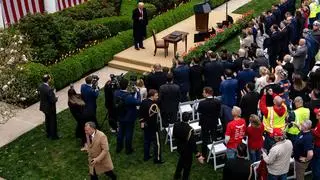
China, now facing a 34 per cent US tariff, and its regional peers could redirect excess steel supply into India, driving down prices and pressuring domestic producers’ margins
| Photo Credit:
PATTY CHEN
India’s steel heavyweights anticipated a new threat as the US unleashed a 27 per cent reciprocal tariff on Indian imports. But steel dodged an additional hit beyond the existing 25 per cent duty (in March). This move, however, could still disrupt the sector by triggering a surge of low-cost imports of nearly 5 million tonnes of the metal coming into the country from global competitors and limiting export opportunities.
Indian steel’s exposure to the US is limited and hence impact is moderate, say trade sources. Just about 95,000 tonnes are exported annually. The US, a $2.2 billion steel market for India, is a small slice of the country’s 100-million-tonne output, most of which feeds domestic demand.
The additional 5-odd mt will primarily be diverted into Indian markets from FTA based countries – Korea and Japan – and ASEAN nations like Vietnam. These markets will have reduced access to the EU. The latter, hit with 25 per cent tariffs, too face limited access to the US, where benchmark hot rolled coil prices are hovering in the $800 – 1000 per tonne range, versus the less than $600 per tonne price being commanded in EU.
The EU has already extended safeguard duty and reduced tariff rate quotas limiting its market access to global steel players.
“We’re exposed and this floating steel could hammer us,” a market participant said.
Steel exporters say, US has imposed anti-dumping duty – countervailing duty (ADD – CVD) on select metal categories from India. “It has to be taken up at a G2G level and if removed, allows us better access to the market,” the exporter said.
China factor
A greater threat looms from China as compared to other Asian steel producers.
China, now facing a 34 per cent US tariff, and its regional peers could redirect excess supply into India, driving down prices and pressuring domestic producers’ margins. The Asian major has exported over 110 mt of steel to global markets, including India, with this oversupply already disrupting international trade flows.
“Global trade flows are changing and the trends are currently being observed,” SAIL Chairman, Amarendu Prakash had previously told businessline.
Steel imports into India stood at 8.9 mt, up 16 per cent y-o-y, led by supplies from Korea – 2.65 mt, up 7 per cent, China – 2.4 mt, down 5 per cent, Japan – 2 mt, up 70 per cent and Vietnam – 0.7 mt, down 4 per cent.
Auto sector woes add fuel to the fire. With US tariffs hitting Indian car parts, steel demand from automakers could falter, piling pressure on producers already lean on exports.
Finished steel exports from India have dipped nearly 40 per cent, y-o-y, to 4.4 mt for April – February period (11M FY25).
India’s 27 per cent tariff looks tame next to Vietnam’s 46 per cent, but the edge is illusory with steel’s pre-existing burden.
Domestic hunger for steel—fuelled by infrastructure and construction—offers a lifeline, and anti-dumping rules might blunt the import surge. India’s DGTR has recommended a 12 per cent safeguard duty on imports, and the proposal is currently under consideration by the Finance Ministry.
“The industry and line ministries are gunning for imposition of the duty,” said an official aware of the developments.
Harsh Bansal, MD of BMW Industries, said, while the US tariffs may disrupt traditional trade flows, they also create space for Indian manufacturers to explore new markets. “An influx of cheaper steel imports into India could hurt domestic producers,” he said.
More Like This


Published on April 3, 2025





